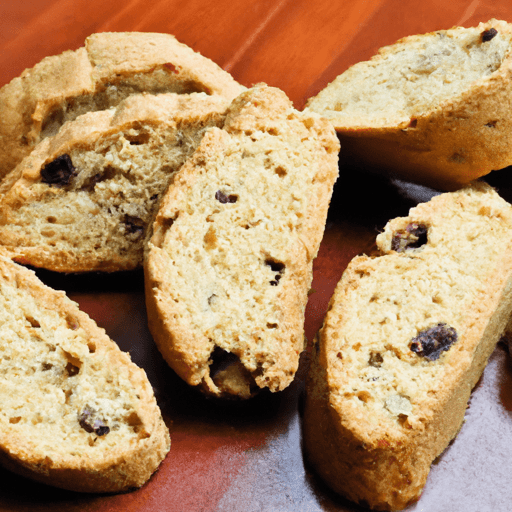The Delightful Biscotti: An Irresistible Italian Treat
If you are seeking a delightful, crunchy treat to accompany your morning espresso or an evening cup of tea, look no further than biscotti. Originating from Italy, biscotti has gained popularity worldwide for its unique texture and distinct flavors. In this blog post, we will delve into the enticing world of biscotti, exploring its taste, common uses in cooking, nutritional value, and uncover some interesting historical facts.
Taste that Spells Satisfaction
Biscotti, also known as cantucci, are twice-baked biscuits renowned for their exceptional crunchiness. These oval-shaped goodies boast a texture unlike any other, with a satisfying snap that sets them apart. Traditionally, biscotti are not overly sweet, making them ideal for pairing with your favorite beverage without overpowering the taste buds.
The flavor profile of biscotti can vary greatly, catering to a wide range of preferences. Classic almond biscotti offer a nutty and slightly sweet taste, while variations such as chocolate-dipped biscotti tease the palate with an extra indulgent twist. Other popular flavors include cranberry and pistachio, hazelnut, and lemon.
Versatile Uses in Cooking
The beauty of biscotti lies in its versatility. Apart from being a delightful snack on its own, biscotti can be incorporated into various culinary creations. One common use is as an accompaniment to hot beverages, adding a bit of crunch and sweetness to every sip.
Another popular application is as a dessert component in dishes such as tiramisu or trifles. Simply dunking biscotti in coffee, liqueur, or dessert wine enhances their tenderness, making them perfect for layering into creamy delights. Biscotti can also be crushed and mixed with melted butter to create a flavorful and textured crust for cheesecakes or pie bases.
Nutritional Value
While biscotti can be an indulgent treat, their nutritional profile offers a silver lining. With their reduced sugar content and absence of butter or oil, biscotti are a lighter alternative to many other sweet treats. Additionally, they are typically made with heart-friendly ingredients such as almonds, nuts, and dried fruits, which offer healthy fats and essential nutrients.
Biscotti are also a great source of energy, making them an ideal snack for those in need of a quick boost during busy days. Their lower moisture content ensures a longer shelf life compared to other baked goods, allowing you to enjoy them for an extended period without compromising quality.
A Glimpse into Biscotti’s History
Biscotti have a rich history that traces back centuries to medieval Italy. These iconic cookies gained popularity due to their long shelf life, making them a suitable choice for long journeys and military campaigns. Biscotti’s twice-baked method of preparation was ideal for ensuring durability during long periods without refrigeration.
The name “biscotti” itself comes from the Latin word “biscoctus,” meaning “twice-cooked.” The traditional method of baking biscotti involved shaping a loaf, baking it, slicing it, and then baking the slices again to achieve the desired crunchiness. This process not only extended the biscotti’s shelf life but also contributed to its distinctive crisp texture.
As the popularity of biscotti spread, its recipes diversified. Almonds, an abundant ingredient in Italy, quickly became a staple in the original biscotti recipe. Over time, bakers began incorporating regional ingredients and flavorings, resulting in the wide array of biscotti flavors we enjoy today.
Conclusion
In the world of baked delights, biscotti reign supreme with their irresistible crunch and diverse flavors. Whether you seek a light snack, a satisfying dessert component, or a tasty accompaniment to your favorite beverage, biscotti delivers on all fronts. Embark on a flavorful journey as you explore the endless possibilities and variations of this historic Italian treat and savor each delectable bite.
Origin: Biscotti, also known as cantuccini, originated in Italy during the Middle Ages. They were first made in the city of Prato, located in the region of Tuscany.
Common Uses: Biscotti are a type of Italian almond cookies that are twice-baked, resulting in a hard and crunchy texture. They are traditionally served with coffee or wine for dipping. Biscotti are also commonly used in various dessert recipes, such as in tiramisu or as a crust for cheesecakes.
Nutritional Benefits: Biscotti are generally made with simple ingredients like flour, sugar, eggs, and often almonds. They are low in fat and cholesterol and a good source of carbohydrates and protein. However, the specific nutritional profile can vary depending on the recipe and ingredients used.
Unique Properties and Historical Significance: The unique feature of biscotti lies in their double baking process. After the initial baking, the log-shaped cookies are sliced and then baked again to achieve their distinctive crunchy texture. This double baking method was initially used to create dry and durable cookies that could be stored for long periods, making them popular for long sea voyages.
Over time, biscotti evolved from practical survival food to a beloved treat. Their popularity spread throughout Italy and eventually beyond its borders. Today, biscotti are enjoyed worldwide and come in a variety of flavors, including chocolate, cranberry, pistachio, and more.




Use the share button below if you liked it.
It makes me smile, when I see it.